For several years I was a rowing coach in competitive sweep oar and sculling boats, with the simple objective of pursuing anything that would make the boat go faster. The long hours of training and intense competition finally took their toll despite the considerable rewards and enjoyment of such a robust and unique sport, but the fascination for rowing stayed with me. Now retired, with a lot more personal time available, I started a quest to find the ideal rowing expedition boat, which would take me to all of my favorite places on the water. My home town of Nelson, located at the top of the South Island of New Zealand, offers a wide variety of nearby row-cruising environments including mountain lakes, spectacular coastal bays and beaches, navigable rivers, and the nearby Marlborough Sounds.
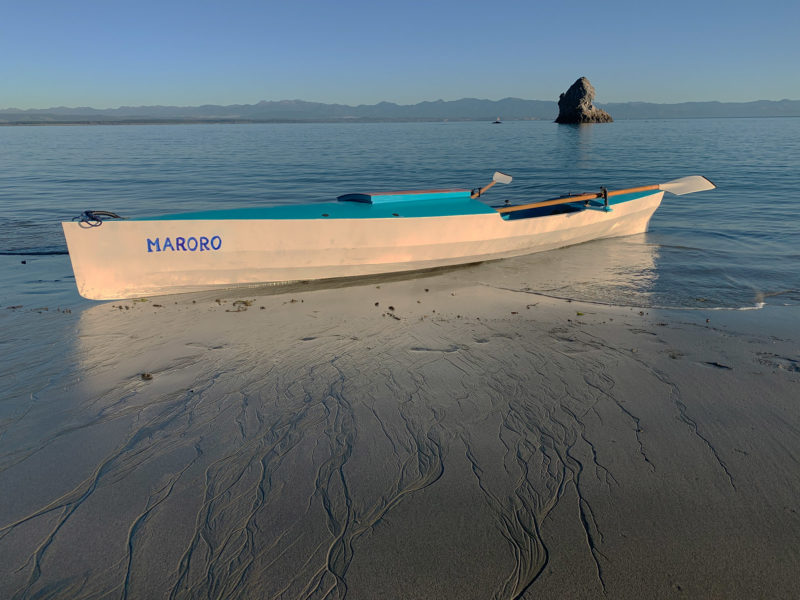 Photographs by Lloyd Houghton
Photographs by Lloyd HoughtonEven though the RowCruiser has protected sleeping quarters, it has a low profile, keeping windage to a minimum.
For the last three years, I have been rowing an Iain Oughtred–designed St. Ayles skiff as part of a crew of five on day outings and occasional overnight camping trips. It dawned that the ultimate touring boat would be a solo rowing boat with comfort, safety, and performance features that would allow me to take on the challenges, simplicity, and excitement of cruising on my own.
The RowCruiser from Angus Boats ticked all my boxes for a solo cruiser. Its designer, Colin Angus, knows row-cruising, having traveled thousands of miles under oars. The RowCruiser is available as plans—either full-sized paper patterns DXF files for cutting ply locally via a CNC cutter—or as a stitch-and-glue kit with pieces CNC-cut from European BS 1088 okoume plywood. Included is a 72-page manual illustrated with 29 drawings and 41 photographs, with the hours required for most of the major operations given at the start of each section. The total build time is about 80 to 100 hours.
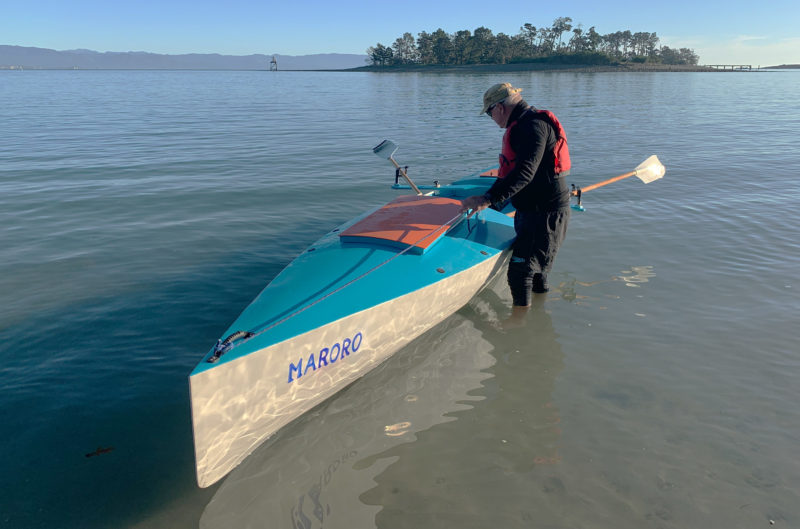
With a draft of about 3-1/2″ at a displacement of 330 lbs, the RowCruiser can sneak into water too thin to row in.
The three pieces for the deck and the three hatch covers are cut from two sheets of 4mm plywood. The planking and the remaining parts are from six sheets of 6mm plywood. The plank sections in the kit are connected by finger joints; builders working from plans alone will butt-join sheets of plywood end-to-end before using the paper patterns. While the kit supplies all of the plywood pieces and the sheer clamps, additional pine, spruce, or fir lumber is required for the framing stringers, sliding seat, and foot brace. For the two pieces for the riggers, 3/4″ knot-free fir other “similarly strong” wood is recommended.
I bought my RowCruiser, so I don’t have first-hand knowledge of its construction, but I’ve spent many hours talking with those who have built theirs. The general consensus has been that it is a relatively easy boat to construct thanks to the excellent manuals, the simplicity of the design, and its tested and proven construction process.
The RowCruiser is an agile, roomy, safe touring boat for day tripping or serious multi-day cruising. The economy and simplicity of the design keeps all aspects of the boat and rig relatively uncomplicated. The boat has five separate flotation compartments. Inspection hatches in the side, rear, and forward compartments provide access to extra storage for small items.
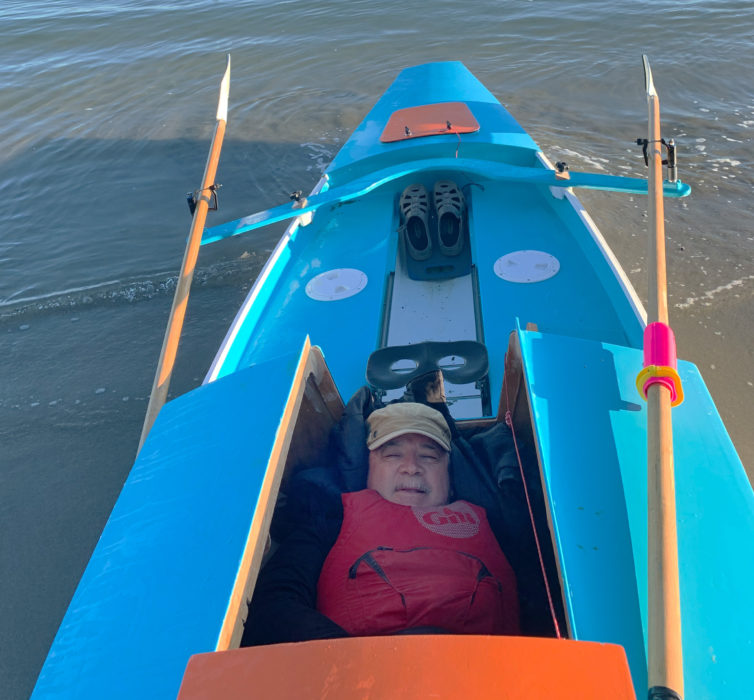
The aft end of the cabin takes advantage of the widest part of the boat, providing good shoulder room for a tired rower.
The sleeping quarters in the cabin stretch over 8′ long and 4′ wide at its widest, with plenty of room for a larger-than-average crew, which I am, at 6′ 1″. Access is gained via a hatchway that can completely slide open over the foredeck. A sleeping bag, pillows, and a couple of self-inflating pads provide excellent sleeping comfort. There is plenty of space for hanging storage nets and any shelves you might choose to add. I’m presently fitting a small portable power station inside the cabin to run interior and navigation lights as well as to charge up my cell phone. Sleeping aboard initially presented some issues with condensation buildup, but the main hatch now has detachable hinges and can be wedged open to facilitate better air movement. While designed specifically as a solo boat, the RowCruiser serves equally well as a passenger-carrying day tripper, with ample room in the cabin’s open hatch area for a companion. The stern has a very large cargo compartment with a large waterproof hatch, which provides easy access to anything you might need while on the water.
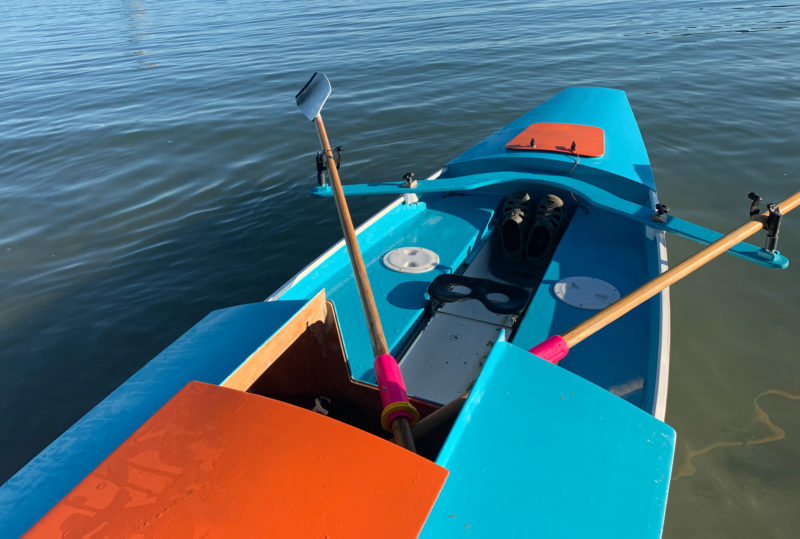
The sliding seat is flanked by two of the boat’s five flotation compartments. The wooden outriggers are made of two pieces, joined with a half lap in the center.
The cockpit is equipped with a sliding seat that rolls smoothly on standard anodized aluminum tracks, which are mounted on the side buoyancy compartments. The rigger is secured to the gunwales by two machine screws with knobs. While the plans detail a simple foot brace with a 1/4″ plywood plate, slotted for straps over the toes, I made a custom stretcher with shoes that are comfortable for long periods on the water.
For transporting and launching the RowCruiser, I use a beach dolly in combination with a boat trailer. A simple pair of planked aluminum-track ramps that clip on to the flat deck facilitate the easy moving of the beach trailer on and off the road trailer.
The boat is impressively stable, even when sitting high in the water without a cruising load. It’s not at all twitchy when stepping aboard, either at the beach or from a dock, or when moving around while afloat. The boat is impressive under oars. Its speed holds up very well against other sculling boats of similar size, even much lighter wherries. A GPS gave my average cruising speed as 3 to 3.5 knots, with a “keen-to-get-there” effort achieving 4 to 4.5 knots. The boat has an overall low profile and negligible windage, helpful for holding a course with the wind on the beam. The 18′ 7″ of waterline and modest rocker provide excellent straight-line tracking, helped by the skeg-like effect created by the garboards’ fine exit and the nearly straight keel line aft. The boat maneuvers remarkably well, turning easily with little effort, while its long, straight keel keeps it tracking well and holding a tight course on long runs.
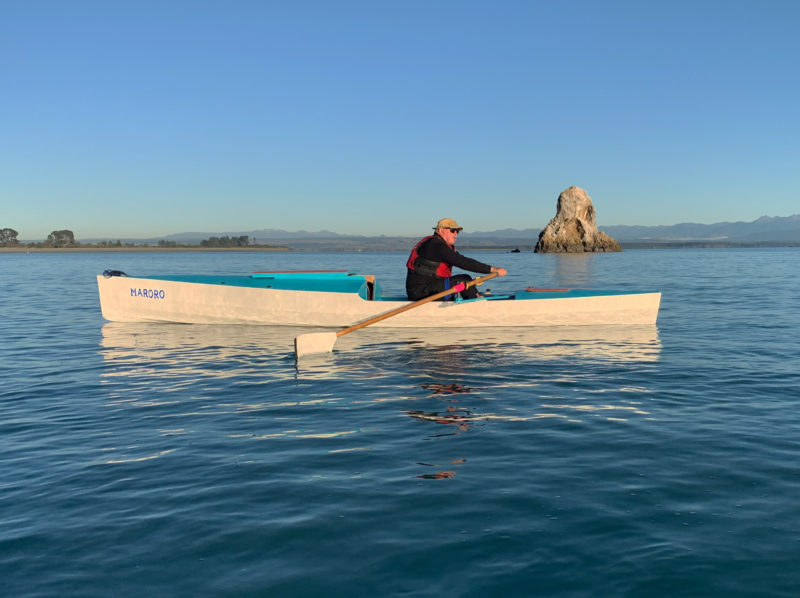
The generous freeboard of the lightly loaded boat here hints at its maximum touring load of 880 lbs.
Angus Boats offers several options for the RowCruiser. There is a high-performance ketch rig with rudder, daggerboard, and outriggers, an addition that can greatly extend the cruising range. For a rower who wants to add a bit more stability to the boat, a pair of 2’ stabilizing floats attach underneath the rowing riggers and may be helpful for rough-water rowing, and certainly helpful when hove-to and when cooking, eating, and sleeping aboard while at anchor. When not required they’ll fit in the cabin. The third option is a galley setup that accommodates a cooker and small wash basin, a deck-mounted water container, and a clamp-on dining tray for use in the cockpit. All items are of a size to be stowed below.
Overall, I have been thrilled with the Angus RowCruiser and the versatility it provides both as a roomy day tripper and multipurpose expedition boat. Quite simply it is a boat where there is a logical place for everything: sleeping, eating, gear storage, rowing, and sailing. Its enduring appeal to me is the means to explore new places on the water, landscapes and seascapes inaccessible on foot or on a larger vessel. The boat can truly inspire solo adventures.![]()
Denis Moriarty of Nelson, New Zealand, made his career as a teacher of geography and outdoor education. Recently retired, he has a strong interest in a variety of outdoor pursuits, environmental education, and promoting the wilderness as a source of inspiration and challenge to people of all ages. He is now free to pursue his consuming interest in rowing and sailing, as well as renovating and building traditional and leading-edge small wooden boats that can be used for coastal cruising. He coaches sailing with Sailability, a community-run program for all ages of sailors with a disability and passion for sailing.
RowCruiser Particulars
[table]
Length/18’ 8.4”
Beam/44”
Volume/147.6 cu ft
Weight/125
Waterline Length/18′ 7 ”
Sprint speed/6 knots
Cruise Speed/4 knots
Maximum recommended touring load/880 lbs
[/table]
The manual and the plans for the RowCruiser are available from Angus Boats, for $149 USD for digital format with DXF files, and $189 for printed full-size patterns (for DXF files add $50). Kits are available from Small Craft Advisor for $1,999.
Is there a boat you’d like to know more about? Have you built one that you think other Small Boats Magazine readers would enjoy? Please email us!
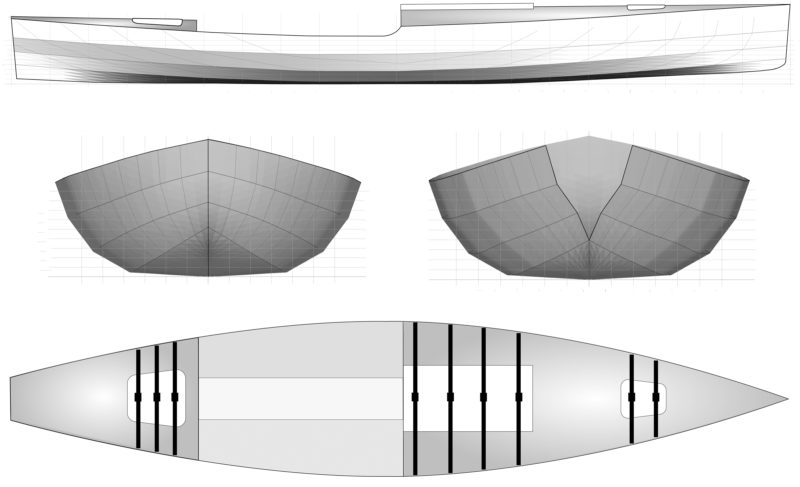
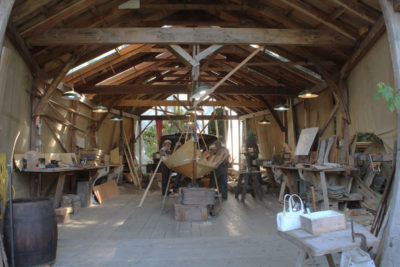
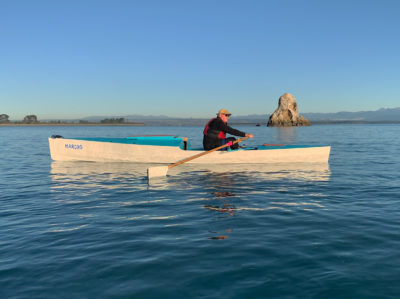
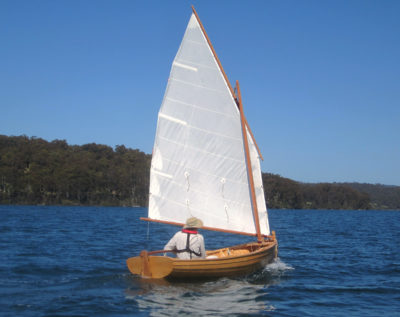
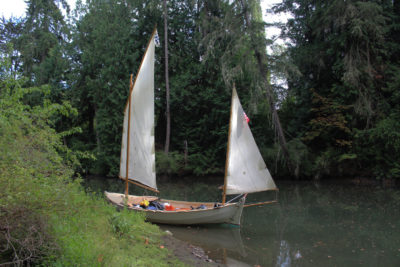
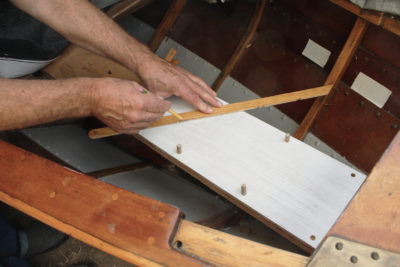
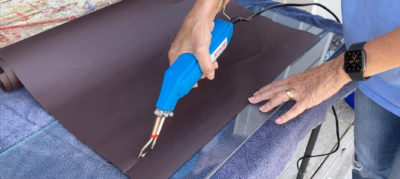
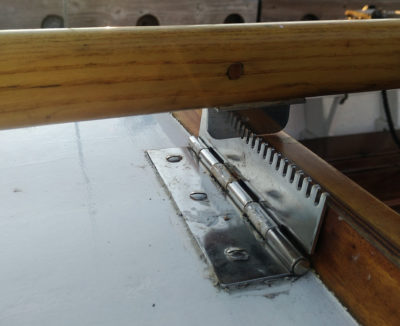
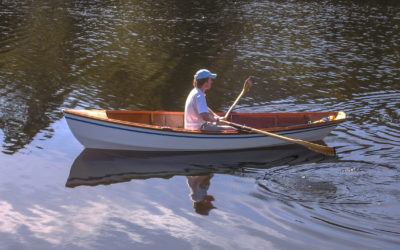
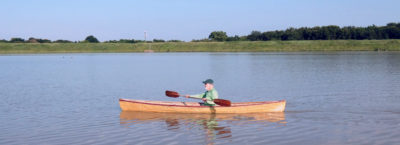
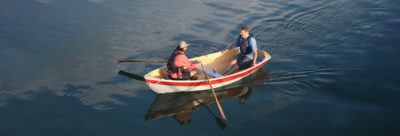
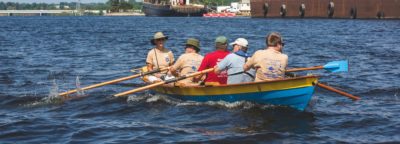
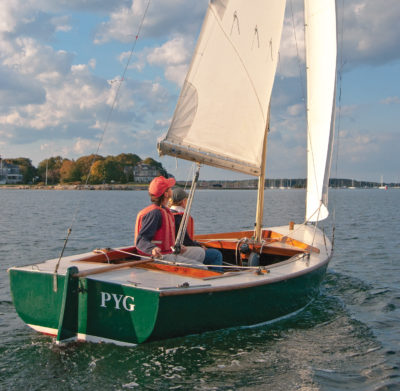
I built one of the first Row Cruisers Colin Angus produced in kit form and in subsequent years rowed it through the Florida Keys in winter. Then 3 years ago I trailered it to the North West Territories of Canada and then rowed it from Hay River along the south shore of the Great Slave Lake and down the MacKenzie River, 1300 km through the arctic and across the Arctic Circle. That boat was my only friend and companion as I rowed through the great empty land which is the Canadian north. Through rapids, storms and out of control wilderness fires the boat never let me down. Can’t say enough good things about this fast stable rowing machine which carries 10 weeks of food and gear swiftly through the water.
Denis and Greg, thanks for the good words about the Row Cruiser and her capabilities.
The Row Cruiser is on my short list of boats to build. As somebody who rowed competitively in school all those years ago, a CLC Expedition Wherry is currently keeping me amused, but the idea of having a similar sized vessel I can actually do a weekend or longer on intrigues me greatly.
Seeing articles like this do not help in the slightest.
Great write up and great work on the RowCruiser! Awesome paint job! Im just about finished building my sailing RowCruiser. Can’t wait to get it on the water. Glad to see a new article about boat. Thanks for sharing
Can you put a little tiny outboard on it?
Un ami breton en a construit un exemplaire.
Il l’a adapté à son programme de navigation en réduisant la cabine avant pour permettre de nager à 2 personnes, ou en solo ou solo avec barreur. Pas de raid mais des navigations à la journée en participant aux nombreux rassemblements de bateaux traditionnels en Bretagne.
Mon épouse et moi allons l’essayer prochainement.
Nous enverrons un commentaire
Online translation:
A Breton friend built a copy.
He adapted it to his navigation program by reducing the forward cabin to allow swimming with 2 people, or solo or solo with coxswain. No raid but day trips by participating in the many gatherings of traditional boats in Brittany.
My wife and I are going to try it soon.
We will send a comment